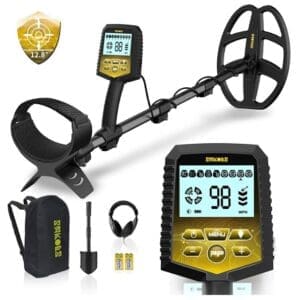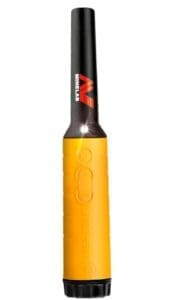There’s a world of adventure waiting for you when you take up metal detecting.
This guide will walk you through the necessary steps to kickstart your journey into this exciting hobby.
From choosing the right equipment to understanding the best locations for treasure hunting, you’ll gain valuable insights that help you uncover hidden treasures.
Whether you’re searching for coins, jewelry, or historical artifacts, your new passion for metal detecting can lead to rewarding discoveries and unforgettable experiences.
Let’s dive in and get you started on your metal detecting adventure!
Uncovering the Secrets of Metal Detector Technology
How Metal Detectors Work: Decoding the Mechanism
Metal detectors operate using electromagnetic fields to locate metal objects buried underground.
When you sweep the detector’s search coil over the ground, it emits a signal that interacts with the conductive properties of metal.
If a metal object is present, it disrupts the electromagnetic field, sending a signal back to the detector, which then alerts you with a sound or visual indicator.
This simple yet effective mechanism is what allows you to unearth hidden treasures.
Different Types of Metal Detectors: Choosing Your Weapon
Selecting the right metal detector can significantly impact your success in the field.
There are primarily four types to consider: VLF (Very Low Frequency), Pulse Induction (PI), Multi-Frequency, and BFO (Beat Frequency Oscillation).
Each type has specific features catered to various detecting needs, such as ground type, target depth, and the kind of metals you wish to find.
Understanding these differences can greatly enhance your detecting experience.
| Type | Features |
| VLF | Best for coins and relics; works on general soil |
| PI | Great for wet sand and saltwater; deep searching |
| Multi-Frequency | Superior versatility; excellent for multiple terrains |
| BFO | Good for beginners; typically lower cost |
| Specialized Models | Target specific needs, like gold prospecting or beach use |

When determining which metal detector to invest in, consider factors like your detecting environment and the types of materials you’re aiming to discover.
Each model has unique strengths and weaknesses, and understanding these can help you select the most suitable option.
For instance, VLF models excel in urban settings, while PI detectors are preferable for underwater pursuits.
- Research reviews and comparisons
- Set a budget that aligns with your needs
- Consider weight and ergonomics for extended use
- Check for warranty and customer support options
- After determining your goals, select the type that best suits your detecting style
| Consideration | Importance |
| Budget | Affects choice of detector and accessories |
| Weight | Can impact comfort during long detecting sessions |
| Terrain | Different detectors perform better in specific conditions |
| Target Type | Some detectors excel at finding particular metals |
| Features | Advanced features can significantly improve user experience |
The Essential Gear: What You Really Need to Start
Beyond the Detector: Must-Have Accessories
In addition to your metal detector, having the right accessories can significantly enhance your detecting experience.

Consider investing in a sturdy digging tool, such as a trowel or a specialized digger, to easily retrieve buried items.
A pinpointer is also highly beneficial for honing in on targets after you’ve dug a hole.
Don’t overlook a good pair of headphones to isolate the detector’s signals from background noise, and a find pouch will help you keep your treasures organized as you search.
Dressing for Success: Clothing and Footwear Considerations
Selecting the appropriate clothing and footwear can greatly impact your metal detecting outings.
Opt for comfortable, breathable fabrics that allow for ease of movement, and choose clothing that protects you from the elements and potential scratches from bushes or thorny plants.
Sturdy, waterproof boots are crucial, as they provide support and keep your feet dry in wet or muddy conditions.
Footwear selection is particularly vital for those long hours spent hunting, as it can prevent fatigue and improve your overall performance. Look for boots with good grip to navigate uneven terrains or slippery surfaces.
Regarding clothing, layering can be an effective strategy. A moisture-wicking base layer combined with a weatherproof jacket ensures you’re comfortable regardless of sudden temperature changes or rain.
Remember to bring a hat and sunscreen for sun protection during those extended outdoor sessions.
Comfort in what you wear can elevate your metal detecting experience, allowing you to focus on the thrill of the hunt rather than distractions from discomfort.
Finding the Right Places to Search
Legal Considerations: Securing Permissions and Avoiding Trouble
Before you start your treasure hunt, check local laws regarding metal detecting in your area.
Certain locations, like national parks, beaches, and historical sites, often require permits or are off-limits altogether.
Always seek permission from landowners if you’re searching on private property.
Failure to do so can result in hefty fines or legal action, so don’t overlook this critical step to ensure your adventures remain enjoyable and trouble-free.
High-Potential Locations: Where to Search for Buried Treasures
Many treasures await in often-overlooked spots. Parks, fairs, and historical battlefields are teeming with relics from the past.
Look for areas where large gatherings occurred, such as old picnic spots or beaches.
Additionally, don’t shy away from searching old neighborhoods where homes have been demolished or renovated, as the ground there can unearth valuable items long forgotten.
Public parks can be goldmines for metal detecting. Families visit these spaces for picnics, games, and celebrations, leaving behind coins, jewelry, and other lost treasures.
Older parks are particularly promising, as they have seen generations of visitors.
Beaches, especially those near tourist resorts, can also yield significant finds like rings and watches, particularly after storms.
Exploring ghost towns or sites of past communities can reveal a rich history through metal detector finds, while urban redevelopment areas often expose long-buried artifacts.
Plan your searches wisely, and you might just strike it rich in your own backyard.
Mastering the Art of Detection
Techniques for Effective Searching: Tips from the Pros
Utilizing the right techniques can drastically enhance your metal detecting experience.
Pros often recommend specific search patterns, such as the grid or zigzag method, to ensure thorough coverage of an area.
Maintain a steady pace, keep your eyes peeled for surface signals, and listen carefully to your detector’s audio tones. Additional tips include:
- Choose the right time: Early mornings or late afternoons offer the best visibility and fewer distractions.
- Use a good pinpointer: This tool helps you locate targets quickly once your detector signals a find.
- Stay aware of your surroundings: Always be mindful of other people and local wildlife.
This approach not only maximizes your efficiency but also enhances the chances of uncovering hidden treasures.
The Importance of Ground Balancing: Getting the Signals Right
Ground balancing fine-tunes your detector to filter out mineralization in the soil, allowing you to capture clearer signals.
Different terrains can emit varying levels of electromagnetic interference, adversely affecting your findings. If you ignore this adjustment, you may end up with false signals or missed items.
Most modern detectors come with automatic ground balancing, but learning manual settings can be beneficial in highly mineralized areas.
Whenever you change locations significantly, rebalancing helps ensure that your machine is configured optimally.
By paying attention to these adjustments, you’ll significantly improve your overall detection success and enjoyment.
Reading Signals Like a Pro
Understanding Tone and VDI: Deciphering the Detector’s Language
Metal detectors use varying tones to indicate the type and depth of a target. By tuning into these sounds, you can get a sense of what’s buried beneath the surface.
Each detector also provides a Visual Display Indicator (VDI) number, which helps you identify metals based on their conductivity.
For instance, a higher VDI number could signal a silver coin, while a lower number might indicate iron.
The key is to practice listening and interpreting both the tone and VDI information, allowing you to make informed decisions as you search.
Common Finds: What the Signals Could Indicate
The signals you receive can lead to a variety of common finds, ranging from nails and pull tabs to coins and jewelry.
Each signal has its own characteristics—knowing these can save you time and help you focus on more rewarding targets.
You’ll need to understand the relationship between tone, VDI, and your soil conditions, The same sound can indicate different items based on these factors.
For example, a strong, clear tone with a high VDI may point to a valuable coin or piece of jewelry, while a shaky or inconsistent signal could signify a trash item like aluminum foil or a bottle cap.
Be aware of these nuances so you will be able to differentiate between worthwhile targets and junk.
Additionally, research local history to know what items are more commonly found in your area, increasing your chances for rewarding digs.
Pay attention to repetition in signals, as this often suggests the presence of multiple objects nearby, which can be especially exciting to uncover.
The Community Connection: Joining and Benefit from Fellow Enthusiasts
Benefits of Networking: Learning from Experienced Detecting Enthusiasts
Connecting with seasoned metal detecting enthusiasts opens up a wealth of knowledge you can tap into.
Experienced detectorists often share invaluable insights into the best locations, techniques, and equipment tailored to your specific interests.
By participating in group outings or discussions, you can gain practical tips and tricks that may take years to discover on your own.
These connections enhance not just your skill level but also your overall experience in the hobby.
Metal Detecting Clubs and Online Forums: Where to Find Your Tribe
Metal detecting clubs and online forums are excellent resources for meeting like-minded individuals who share your passion.
Local clubs often organize events, hunts, and educational sessions that foster a learning environment.
Online platforms like Facebook groups and dedicated forums provide opportunities to discuss finds, share stories, and seek advice from a broader community.
This interconnectedness enhances your learning journey.
To find a club near you, simply search for “metal detecting clubs” along with your locality. Also check out national organizations that may have a local chapter.
Online forums such as Findmall or DetectorProspector offer chat rooms and threads covering everything from gear recommendations to archaeological discussions.
These communities can not only provide camaraderie and friendship, but also open doors to group hunts, where collective knowledge amplifies your chances of uncovering valuable treasures.
Legal Treasure Hunting: Understanding Property Rights and Regulations
Metal Detecting Laws: What You Need to Know
Before heading out on your treasure hunting journey, familiarize yourself with local laws.
Metal detecting regulations vary significantly depending on your location.
For example, many states require permits for searching in public parks or certain historical sites, while others strictly prohibit it altogether.
Always check with local authorities or land management agencies to avoid potential fines and misunderstandings.
To Keep or Not to Keep: Understanding Finders’ Rights
Finders’ rights dictate how you can claim ownership of items you discover while metal detecting.
Generally, if you find something on private land, you need permission from the landowner to keep it.
However, public lands present a different set of rules. Treasure troves, which are defined as items left deliberately hidden, usually require you to report your findings to local authorities before claiming ownership.
To navigate finders’ rights effectively, consider researching applicable treasure laws in your area. In many instances, the definition of ownership depends on where you find an item.
For example, if you stumble upon ancient relics or artifacts, you might have to report these to local or national historical authorities regardless of finders’ rights.
Knowing the specifics about what you can or cannot keep will save you legal trouble and help you engage more responsibly as you hunt for treasure.
Tips for Preserving and Cleaning Your Finds
To maintain the value, appearance, and historical significance of your finds, you’ll need to take great care of them.
Here are some vital tips to help you preserve and clean your treasures effectively:
- Handle your items with care, wearing gloves to prevent oils from your skin from transferring.
- For coins, use a mild soap and water solution, avoiding abrasive materials.
- Store items in acid-free containers to minimize deterioration.
- Research specific cleaning methods for each material type before proceeding.
- Consider consulting with a professional conservator for valuable or unique items.
This knowledge empowers you to protect your findings and maintain their integrity.
Restoration Techniques: How to Clean and Maintain Different Materials
Each type of material, whether it’s metal, wood, or ceramics, demands specific cleaning and restoration techniques.
For coins, a gentle soap and water wash works well, while wooden items might require special oils to retain moisture and prevent cracking.
Always seek out best practices tailored to the specific material to avoid damage.
Displaying Your Treasures: Creative Ways to Showcase Finds
Consider showcasing your finds in a way that not only highlights their beauty but also tells a story.
Artistically displayed finds can transform ordinary collectibles into eye-catching focal points in your home.
Arrange your finds within shadow boxes, incorporate them into home decor, or create themed displays to reflect your treasure-hunting adventures.
For instance, you might create a shadow box that includes a timeline of your finds, each item meticulously showcased alongside photographs of the location where they were discovered.
By doing so, you weave a narrative that not only celebrates your achievements as a metal detectorist but also invites curious visitors to engage with your hobby.
This approach not only preserves the items but gives them a place of honor in your personal space.
Final Words
Metal detecting can be both rewarding and thrilling. Start by choosing the right detector that fits your needs and budget, and familiarize yourself with its features.
Before heading out, research local regulations and potential sites for treasure hunting.
Don’t forget to equip yourself with imperative accessories like headphones and diggers for an enjoyable experience.
As you practice and refine your skills, you’ll discover the satisfaction that comes from uncovering hidden treasures.
Enjoy the adventure, and every find will add to your growing passion for this engaging hobby!



